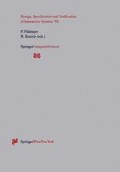Abstract
This paper summarises a survey presentation on formal specification techniques and formal development methods. Currently, there is a significant amount of interest in the application of these methods to the specification, design, validation and verification of interactive systems (see for instance [9, 14] and several papers in these proceedings). This leads to the following questions: are general purpose techniques applicable? Is it better to design a specific formal approach for this kind of system?
After a brief survey of the main mature techniques, some examples of techniques specific to some application domains are discussed.
Access this chapter
Tax calculation will be finalised at checkout
Purchases are for personal use only
Preview
Unable to display preview. Download preview PDF.
References
Aho A., Sethi R., Ullmann J., Compilers, Addison-Wesley, 1986.
Arnold A., Gaudel M-C., Marre B., An Experiment on the Validation of a Specification by Heterogeneous Formal Means: the Transit Node, March 1995.
Palanque Ph., Bastide R., Spécifications Formelles pour l’ingiénirie des interfaces homme-machine, Technique et Science Informatique, vol. 14, n° 4, pp. 473–500, 1995.
Bidoit M., Kreowski H.-J., Lescanne P., Orejas F., Sannella D. (editors), Algebraic System Specification and Development: a survey and annotated bibliography, LNCS n° 501, Springer Verlag, 1991.
Bidoit M., Gaudel M.-C., Mauboussin A., How to make algebraic specifications more understandable ? An experiment with the PLUSS specification language, Science of Computer Programming, Vol. 12, n°1, June 1989, pp. 1–38.
Chretienne P., Timed Petri Nets, Journal of Systems and Software, vol. 6, 1986.
Craigen D., Kromodimoeljo S., Meisels I., Pase B and Saaltink M., EVES: an overview, LNCS n° 551, Springer Verlag, 1991, pp. 389–405.
Craigen D., Gerhart S., Ralston T., On the use of formal methods in industry -an authoritative assessment of the efficacy, utility, and applicability of formal methods to systems design and engineering by the analysis of real industrial cases, Report to the US National Institute of Standards and Technology, March 1993.
Dix A. J., Formal Methods for Interactive Systems, Computers and People, Academic Press, London, 1991.
Emerson E.A., Temporal and Modal Logic, in Handbook of Theoretical Computer Science, vol. 8, Van Leeuwen J. editor, Elsevier, 1990.
Garlan D. and Delisle, N. “Formal Specifications as Reusable Framework”, VDM’90, LNCS n° 428, Springer Verlag, 1990, pp. 150–163.
Gaudel M-C., Algebraic Specifications, Chapter 22 of Software Engineer’s Reference Book, John McDermid ed., Butterworths, 1991.
Harel D., Statecharts: a visual formalism for complex systems, Science of Computer Programming, Vol.8, n°3, June1987, pp. 231–274.
Harrison M., Thimbleby H., (editors), Formal Methods in Human-Computer Interaction, Cambridge University Press, 1990.
Hoare C.A.R., Communicating Sequential Processes, Prentice Hall International, 1985.
ISO, LOTOS, IS-8807, 1989.
Jones, C.B. Systematic Software Development using VDM, 2nd edition, Prentice Hall, 1990.
Lincoln P. and Rushby J., A Formally Verified Algorithm for Interactive Consistency under a Hybrid Fault Model, IEEE 23th International Symposium on Fault-Tolerant Computing (FTCS), 1993, pp. 402–411.
Maibaum T., Taking more of the Soft out of Software Engineering, IEEE International Workshop on Software Specification and Design (IWSSD 93], 1993, pp. 2–7.
Milner R., A Calculus of Communicating Systems, LNCS n° 92, Springer Verlag, 1980.
Neilsen M., Havelund K., Wagner K. and George C., The RAISE Language, Method and Tools, Formal Aspects of Computing, vol 1, n° 1, 1989, pp. 85114.
Rushby J., Formal Methods and the Certification of Critical Systems, SRI-CSL-93–07 report, Nov. 1993, 308 pages.
Spivey J.M., The Z notation: a reference manual, Prentice Hall International, 2nd edition, 1992.
Author information
Authors and Affiliations
Editor information
Editors and Affiliations
Rights and permissions
Copyright information
© 1995 Springer-Verlag/Wien
About this paper
Cite this paper
Gaudel, MC. (1995). Formal Specification Techniques for Interactive Systems. In: Palanque, P., Bastide, R. (eds) Design, Specification and Verification of Interactive Systems ’95. Eurographics. Springer, Vienna. https://doi.org/10.1007/978-3-7091-9437-9_2
Download citation
DOI: https://doi.org/10.1007/978-3-7091-9437-9_2
Publisher Name: Springer, Vienna
Print ISBN: 978-3-211-82739-0
Online ISBN: 978-3-7091-9437-9
eBook Packages: Springer Book Archive

